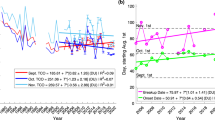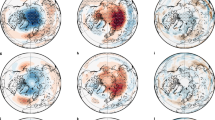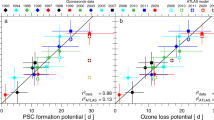Abstract
Recent observations by Farman et al.1 reveal remarkable depletions in the total atmospheric ozone content in Antarctica. The observed total ozone decreased smoothly during the period from about 1975 to the present, but only in the spring season. The observed ozone content at Halley Bay was ∼30% lower in the Antarctic spring seasons (October) of 1980–84 than in the springs of 1957–73. No such obvious perturbation is observable in other seasons, or at other than the very highest latitudes in the Southern Hemisphere, and the magnitude of the observed change there far exceeds climatological variability2. We present here balloonsonde ozone data3,4 which show that these ozone changes are largely confined to the region from about 10 to 20 km, during the period August to October. We show that homogeneous (gas phase) chemistry as presently understood cannot explain these observed depletions. On the other hand, a unique feature of the Antarctic lower stratosphere is its high frequency of polar stratospheric clouds5, providing a reaction site for heterogeneous reactions. A heterogeneous reaction between HCl and ClONO2 is explored as a possible mechanism to explain the ozone observations. This process produces changes in ozone that are consistent with the observations, and its implications for the behaviour of HNO3 and NO2 in the Antarctic stratosphere are consistent with observations of those species there, providing an important check on the proposed mechanism. Similar ozone changes are obtained with another possible heterogeneous reaction, H2O + ClONO2.
This is a preview of subscription content, access via your institution
Access options
Subscribe to this journal
Receive 51 print issues and online access
$199.00 per year
only $3.90 per issue
Buy this article
- Purchase on SpringerLink
- Instant access to full article PDF
Prices may be subject to local taxes which are calculated during checkout
Similar content being viewed by others
References
Farman, J. C., Gardiner, B. G. & Shanklin, J. D. Nature 315, 207–210 (1985).
Angell, J. K. & Korshover, J. Mon. Weath. Rev. 111, 901–921 (1983).
Ozone Data Wld, 25, 192–199 (1984).
Chubachi, S. Mem. natn. Inst. pol. Res., spec. Iss. 34, 13–19 (1984).
McCormick, M. P. Adv. Space Res. 2, 73–86 (1983).
Heath, D. F., Bhartia, P. & Schlesinger, B. EOS 66, 1009 (1985).
Krueger, A. J. & Stolarski, R. S. EOS 66, 838 (1985).
Solomon, S., Garcia, R. R. & Stordal, F. J. geophys. Res. 90, 12981–12990 (1985).
Labitzke, K. Phil. Trans. R. Soc. 296, 7–18 (1980).
Garcia, R. R. & Solomon, S. J. geophys. Res. 88, 1379–1400 (1983).
Solomon, S. & Garcia, R. R. J. geophys. Res. 89, 11633–11644 (1984).
WMO/NASA The Stratosphere (in the press).
Molina, L. T., Molina, M. J., Stachnik, R. A. & Tom, R. D. J. phys. Chem. 89, 3779–3781 (1985).
JPL/NASA Chemical Kinetics and Photochemical data for Use in Stratospheric Modeling (JPL 85–37, 1985).
Rowland, F. S., Khwaja, H. & Sato, H. J. Phys. Chem. (in the press).
Groves, K. S. & Tuck, A. F. Q. Jl R. met. Soc. 106, 125–142 (1980).
Williams, W. J., Kosters, J. J. & Murcray, D. G. J. geophys. Res. 87, 8976–8980 (1982).
Austin, J. A., Garcia, R. R., Russell, J. M., Solomon, S. & Tuck, A. F. J. geophys. Res. 90, 5477–5485 (1986).
McKenzie, R. L. & Johnston, P. V. Geophys. Res. Lett. 11, 73–75 (1984).
Noxon, J. F., Henderson, W. R. & Norton, R. B. J. geophys. Res. 88, 5240–5248 (1983).
Author information
Authors and Affiliations
Rights and permissions
About this article
Cite this article
Solomon, S., Garcia, R., Rowland, F. et al. On the depletion of Antarctic ozone. Nature 321, 755–758 (1986). https://doi.org/10.1038/321755a0
Received:
Accepted:
Issue Date:
DOI: https://doi.org/10.1038/321755a0



